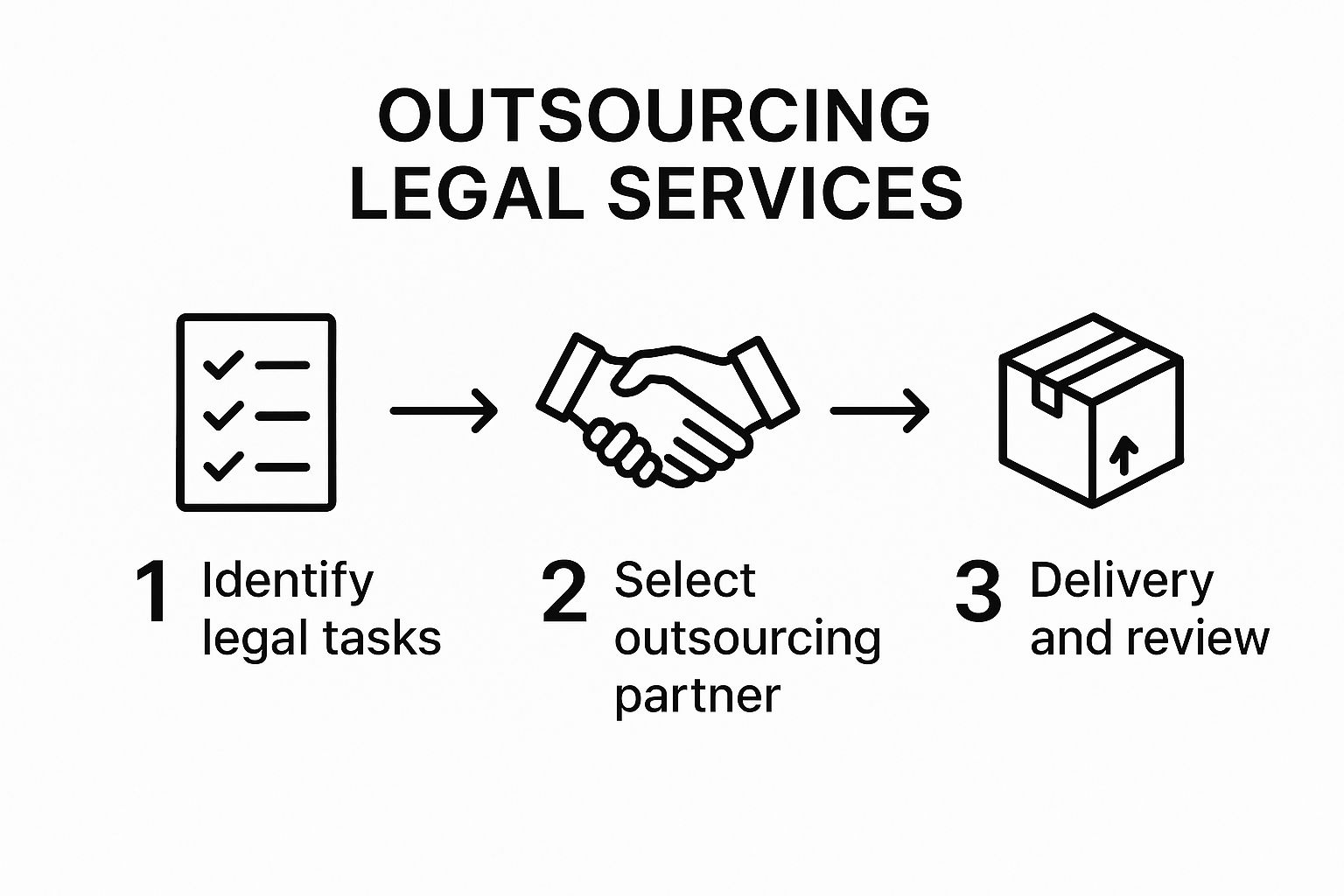
 22 minutes read
22 minutes read
Let's cut the fluff. The term outsourcing of legal services sounds corporate and cold, but here's what it really means: you stop paying your sharpest legal minds to do soul-crushing administrative work. It means taking the tedious, time-sucking tasks—think document review that makes your eyes glaze over—and handing them to a pro who does it faster, cheaper, and probably better.
This isn't just about shaving a few points off your overhead. It's a strategic gut-check. It's about freeing up your senior attorneys to do what you actually pay them for: winning cases and bringing in clients.

Let's be brutally honest. That little thought about outsourcing probably popped into your head at 2 AM while you were buried under a mountain of discovery documents, wondering if this was really the best use of a six-figure legal education.
You’re not alone. The dirty little secret of the legal industry is that most firms are hemorrhaging cash and burning out their best talent on work that doesn't require a partner’s brainpower.
This isn’t about shipping your entire firm overseas or replacing your trusted paralegal. It's about being ruthlessly efficient. It's about a fundamental shift from the "we have to do everything ourselves" martyrdom complex to asking, "What is the absolute best use of my team's time right now?"
In the legal world, we have a tendency to romanticize the grind—the late nights, the endless paperwork. But that grind is a profit killer. Every hour a senior associate spends formatting citations or redlining a boilerplate contract is an hour they aren't spending on high-value case strategy or charming a potential new client.
Think about it. You’re paying a premium salary for someone to peel potatoes, when you hired a Michelin-star chef. Sure, they can do it. But is that really why they're on your payroll? This is where the outsourcing of legal services stops being a nice-to-have and becomes a core survival tactic.

It’s time to stop paying premium rates for administrative work disguised as legal practice. The goal isn't to work harder; it's to work smarter by surgically removing the tasks that drain your resources and morale.
Here's a no-fluff breakdown of what you're really spending versus what you could be saving.
| Task Area | The In-House Grind (Real Cost & Time) | The Outsourced Edge (Benefit & Focus) |
|---|---|---|
| Document Review | Hours of associate time at a high billable rate, leading to burnout and pulling them from critical analysis. | A specialized team handles volume review at a lower cost, freeing your associates for actual strategy and client hand-holding. |
| Legal Research | A junior attorney spends a full day on Westlaw, racking up billable hours that you know the client is going to question. | An expert researcher with deep database knowledge finds what you need faster and for a fixed fee. Your team gets answers, not bills. |
| Contract Management | Your best paralegal is bogged down organizing and redlining standard NDAs instead of preparing for a major trial. | A contract specialist manages the entire lifecycle, ensuring compliance and freeing your team for high-stakes litigation prep. |
The difference is stark. You're not just saving money on salary; you're reallocating your most valuable resource—your team's brainpower—to where it actually makes you money.
This isn't just a hunch I have; it's a global trend backed by serious cash. The Legal Process Outsourcing (LPO) market hit about $15.3 billion in 2023, and it's projected to explode to $36.3 billion by 2027. That’s not just a few firms trying to save a buck; it’s a strategic realignment of the entire legal industry.
Outsourcing isn't some fringe idea anymore. It's a core business strategy for firms that want to stay competitive and, you know, profitable. While you’re debating the merits of doing everything in-house, your competition is scaling up, cutting costs, and focusing their energy where it counts.
The real question is, can you afford not to? The costs go way beyond the balance sheet:
Ready to see exactly how much you could save? Understanding the market rates for skilled professionals is the first step. For a detailed breakdown, check out this guide on virtual paralegal rates. It’s a real eye-opener.

Alright, let's get strategic. Deciding what work to hand off can feel like a high-stakes game of Jenga. Make the wrong move, and you risk damaging client trust and your firm's hard-won reputation. The goal isn’t to outsource everything that isn't nailed down; it's to strategically remove the repetitive, time-consuming tasks so your best people can focus on winning.
Not all tasks are created equal. Trying to apply a one-size-fits-all outsourcing plan is a rookie mistake I’ve seen crash and burn. I watched a firm try to hand off initial client intake calls and then scratch their heads when conversion rates plummeted. That first impression, that critical human connection? That’s your turf. You defend that hill.
To simplify things, I break tasks down into three distinct categories. This is your playbook for smart delegation.
This is the low-hanging fruit. The stuff that’s essential but doesn't require a senior partner's strategic genius. These tasks are high-volume, process-driven, and, frankly, the reason your junior associates look perpetually exhausted.
Outsourcing these functions isn't just about the bottom line—it’s about reclaiming your team’s most valuable asset: their sanity.
This is where you gain a real competitive edge. These tasks demand more skill and tighter integration than the no-brainers, but the payoff in efficiency is massive when done right. This requires a true partnership, not just a transactional arrangement where you lob tasks over the wall.
Here's what I mean:
These are the kinds of moves that separate the firms that are just getting by from the ones that are truly thriving.
Now for the most important part: what you absolutely, positively should not outsource. These are the crown jewels of your firm. They define your brand, forge your client relationships, and ultimately, win your cases. Guard them with your life.

You can delegate a task, but you can never delegate your relationship with a client. The moment you put a third party between you and the person who pays your bills is the moment you start losing.
My non-negotiable list of what always stays in-house:
The smartest firms don’t see outsourcing as a way to replace their team. They see it as a way to empower them. By clearing away the junk, you create the space for your top talent to do the high-impact work that actually matters.
Alright, let's talk about choosing a provider for the outsourcing of legal services. Get ready to be buried under slick sales decks, vague promises of "proprietary AI," and enough buzzwords to make a venture capitalist blush. It’s a jungle out there, and most of it is just noise designed to separate you from your money.
You’re not just looking for a vendor; you’re looking for a partner. A bad one won't just cost you money—they'll cost you clients, credibility, and countless sleepless nights. I've been through this process more times than I care to admit, and I’ve developed a battle-tested vetting system to cut through the marketing fluff.
First, your gut is a surprisingly effective filter. If a potential vendor’s pitch feels more like a timeshare presentation than a professional consultation, run. Their sales team is often a direct reflection of their service culture.
Keep an eye out for these classic warning signs:
A vendor who gets defensive during the sales process will be an absolute nightmare to work with when a real problem crops up. Trust me on this.
A Request for Proposal (RFP) shouldn't just be a formality; it should be a weapon. Stop asking questions that allow for fluffy, yes/no answers. Make them show their work.
Instead of asking, "Do you have a quality assurance process?" dig deeper. Ask, "Describe your QA process in detail, including the specific steps taken when an error is identified and the average error rate for a project of our scope." See the difference? One invites a lie; the other demands a process.

Your RFP is your first line of defense. It filters out the pretenders and forces the real contenders to prove they have the substance to back up their style. A well-crafted RFP saves you from dozens of pointless sales calls.
The goal is to make it much easier for them to be honest than to invent a plausible-sounding story. This approach quickly reveals who has actually been in the trenches and who just hired a great copywriter.
This process flow shows the basic steps for identifying tasks, selecting a partner, and managing the delivery of legal services.

The main takeaway here is that choosing a vendor isn't just one step—it's the critical middle phase that connects your internal needs with the final work product.
Many firms look to established hubs for these services. For instance, India’s emergence as a dominant player has been significant, leveraging its highly skilled, English-speaking workforce to capture a huge share of global LPO demand. This market hosts thousands of legal pros handling millions of transactions, offering a blend of cost savings and deep expertise.
Never, ever sign a long-term, high-value contract without running a pilot project first. A pilot is your real-world test drive. It’s where promises meet reality. A sales pitch can be perfect, but a pilot project doesn’t lie.
Here’s how to structure it for maximum insight:
This small, upfront investment of time and money can save you from a catastrophic long-term partnership. If you need more guidance on what to look for, our guide on the legal process outsourcing journey offers a deeper look. Finding the right partner is tough, but it's far less painful than untangling yourself from the wrong one.

So, you’ve signed the contract. The vendor promised the world, and you’re already mentally calculating the cost savings. Time to pop the champagne, right?
Not so fast.
The ink is barely dry, and you're entering what is arguably the most dangerous phase: integration. This is the messy middle where most outsourcing of legal services initiatives either quietly succeed or spectacularly implode.
Too many firms think you can just email a task list and watch the magic happen. That’s a fantasy. Integrating an external team is less like flipping a switch and more like a delicate transplant surgery—it requires precision, planning, and a ton of communication.
Your first 90 days are everything. This period sets the tone for the entire relationship. If you’re hands-off and just assume your new team will "figure it out," you’re setting yourself up for a painful correction down the road. You need a framework, not just good intentions.
Forget the generic "welcome aboard" email. You need a structured plan that covers technology, workflow, and—most importantly—people. Small misalignments in week one become catastrophic failures by month three.

This isn't a 'set it and forget it' solution. Treat your outsourced team like a remote extension of your firm, not a faceless service provider. The more integrated they are, the more ownership they'll take.
Think of it as onboarding a new hire, but with extra layers of complexity. You're bridging gaps in firm culture, time zones, and communication styles. Ignoring this reality is just asking for trouble.
I've seen integrations go sideways for the dumbest reasons—like nobody explaining the firm’s preferred citation format or access credentials not being ready on day one. To avoid these unforced errors, you need a disciplined, methodical approach.
Here’s a simple, battle-tested 90-day plan:
This structure prevents the slow drift into chaos that dooms so many outsourcing partnerships. It forces accountability on both sides from the start.
Now for the trickiest part: your in-house team. Let's be real—they're probably nervous. They see an outsourced team coming in and immediately think, "Are they trying to replace me?" You have to get out in front of this narrative, and fast.
Frame the new resources as support, not a replacement. This isn't about cutting headcount; it's about making their jobs better. It's about offloading the monotonous document review so your star paralegal can finally focus on high-level trial prep.
Get their buy-in by involving them in the integration. Ask them to help document workflows or lead a training session. When your team sees the outsourced staff as a tool to make them more effective, the resistance just melts away. For those considering this model, exploring the dynamics of virtual paralegal employment can offer valuable insights into making this relationship work.
Ultimately, successful integration is an active process. It demands clear communication, a solid framework, and a bit of empathy. Nail this, and you’re not just outsourcing tasks—you’re building a powerful, efficient extension of your firm.
So, you’ve pulled the trigger. You've handed off the mind-numbing document review and the late-night legal research. Now for the million-dollar question: is it actually working?
If your answer is a vague, "Yeah, I think so," you're flying blind. You didn't just trade one set of headaches for another, did you? Hope is not a strategy, and gut feelings don't impress partners when it’s time to review the budget. You need hard, undeniable data that proves this was a smart business decision.
This isn't just about keeping your vendor honest. It’s about proving the value of the outsourcing of legal services to yourself, your team, and anyone who signs the checks. Without a rock-solid system for measuring your return on investment, you're just gambling.
The most common mistake I see is firms equating "cost savings" with the vendor’s monthly invoice. That’s kindergarten-level ROI. The invoice is just one piece of a much bigger puzzle. Real ROI is about measuring the impact of those savings on your firm's overall health.
You need to build a simple but powerful performance dashboard. Forget vanity metrics. We're tracking the numbers that directly affect your bottom line and your sanity.
Here are the non-negotiable KPIs that should be on it:
Let's get real about those reclaimed hours. If outsourcing frees up 10 hours a week for a senior partner who bills at $600 an hour, that’s not just a "soft benefit." That is $6,000 in potential revenue-generating activity per week. That’s time they can now spend on client development, complex strategy, or mentoring associates.

You didn't outsource to save a few bucks on a paralegal. You outsourced to unlock the full earning potential of your most expensive, most valuable talent. If you're not measuring that, you're missing the entire point.
This isn't just a feel-good number; it's a powerful financial lever. When you can walk into a partners' meeting and say, "Our outsourcing initiative freed up 40 partner-level hours last month, creating capacity for an additional $24,000 in billable work," the conversation changes. Instantly.
Ultimately, everything we do is in service of the client. An efficient, well-run back office translates directly into a better client experience. You can measure this, too.
Are you getting work back to clients faster? Are your invoices more predictable because you're using fixed-fee outsourced services? Consider adding a simple question to your post-engagement client surveys: "How would you rate the speed and efficiency of our service on your recent matter?"
This industry is only getting bigger for a reason. The Legal Process Outsourcing industry is expected to explode from USD 21.6 billion in 2025 to a staggering USD 157.9 billion by 2035. This growth is fueled by firms realizing that focusing on core legal strategy is the key to winning. You can discover more insights on the future of the legal services market on FutureMarketInsights.com.
Measuring your ROI isn't an academic exercise. It's the mechanism that turns outsourcing from a cost center into a strategic weapon for growth.
Alright, you’ve made it this far, which means you’re either seriously considering this or just really enjoy my witty prose. Either way, let’s tackle the nagging questions that are probably bouncing around in your head. No corporate jargon, no fluff—just straight answers.
Let's dive right in.
This is the big one, isn't it? The fear that a client will find out and think you’re running their sensitive case from a beach somewhere.
For most back-office tasks—think document review, legal research, or data entry—clients don’t need a play-by-play. They care about two things: results and the final bill. You’re not subcontracting your legal judgment, you're just getting the administrative heavy lifting done more efficiently.
You can, and should, frame this as a strategic benefit. A simple line like, "We use a global team of specialists for routine work, which keeps your costs down and allows our senior attorneys to focus exclusively on high-level strategy for your case," is not only transparent but also smart business.
However, for any task that is client-facing, transparency is non-negotiable. Don’t try to pass off an outsourced paralegal as a full-time employee. Most clients will respect the savvy of building an efficient, modern firm.
Let’s not sugarcoat this: data security is the single biggest risk in the outsourcing of legal services. One mistake can compromise attorney-client privilege, violate data privacy regulations like GDPR, or simply vaporize your firm's reputation. It’s the stuff of nightmares.
This is exactly why the vendor vetting process we talked about earlier is so critical.

If you ask a potential vendor about their data encryption methods and they get defensive, that’s not just a red flag—it’s a giant, flashing, neon sign telling you to run for the hills.
You need to grill them on everything:
A great partner will have clear, confident answers. A bad one will try to change the subject.
Salespeople love to throw around eye-popping numbers like "cut costs by 70%!" While that sounds great in a PowerPoint, reality is a bit more grounded. For highly commoditized, process-driven tasks, direct cost savings in the 40-60% range are absolutely achievable.
But the real, game-changing ROI isn't just about the direct savings. It's about the opportunity cost you reclaim.
The true win is the newfound capacity you unlock in your most valuable—and most expensive—team members. When your top litigator isn’t spending her Sunday night proofreading deposition summaries, she’s free to bring in the next big client. That's where the real money is made.
Notice I didn't say if they make a mistake. I said when. People are human. Errors will happen. The crucial difference between a true partner and a disposable vendor is how they respond when things go wrong.
This is where your Service Level Agreement (SLA) becomes your best friend. A well-drafted SLA isn't just a legal document; it's a rulebook for the relationship. It must clearly define:
A great partner will have a transparent QA process, take immediate ownership of their mistakes, and present a clear plan to prevent them from happening again. If their first instinct is to point fingers or make excuses, it’s time to find a new vendor. Your firm’s reputation is on the line.
Ready to stop overpaying for repetitive work and unlock your firm's true potential? (Toot, toot!) At HireParalegals, we connect you with pre-vetted, experienced legal professionals so you can build your dream team in hours, not months. See our curated talent and find your perfect match today.